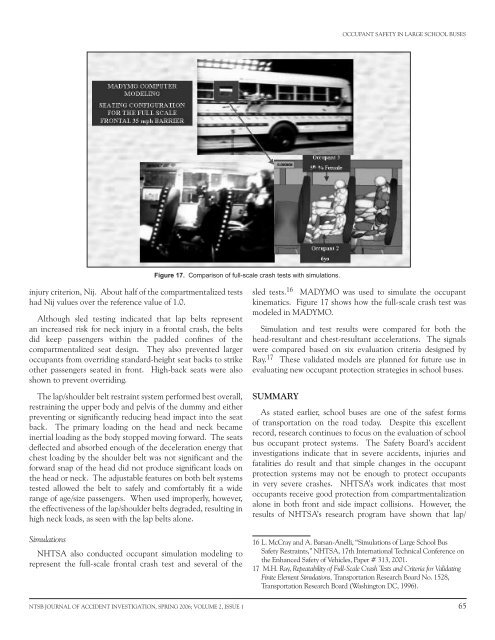Journal of Accident Investigation
Journal of Accident Investigation
Journal of Accident Investigation
Create successful ePaper yourself
Turn your PDF publications into a flip-book with our unique Google optimized e-Paper software.
injury criterion, Nij. About half <strong>of</strong> the compartmentalized tests<br />
had Nij values over the reference value <strong>of</strong> 1.0.<br />
Although sled testing indicated that lap belts represent<br />
an increased risk for neck injury in a frontal crash, the belts<br />
did keep passengers within the padded confines <strong>of</strong> the<br />
compartmentalized seat design. They also prevented larger<br />
occupants from overriding standard-height seat backs to strike<br />
other passengers seated in front. High-back seats were also<br />
shown to prevent overriding.<br />
The lap/shoulder belt restraint system performed best overall,<br />
restraining the upper body and pelvis <strong>of</strong> the dummy and either<br />
preventing or significantly reducing head impact into the seat<br />
back. The primary loading on the head and neck became<br />
inertial loading as the body stopped moving forward. The seats<br />
deflected and absorbed enough <strong>of</strong> the deceleration energy that<br />
chest loading by the shoulder belt was not significant and the<br />
forward snap <strong>of</strong> the head did not produce significant loads on<br />
the head or neck. The adjustable features on both belt systems<br />
tested allowed the belt to safely and comfortably fit a wide<br />
range <strong>of</strong> age/size passengers. When used improperly, however,<br />
the effectiveness <strong>of</strong> the lap/shoulder belts degraded, resulting in<br />
high neck loads, as seen with the lap belts alone.<br />
Simulations<br />
NHTSA also conducted occupant simulation modeling to<br />
represent the full-scale frontal crash test and several <strong>of</strong> the<br />
Figure 17. Comparison <strong>of</strong> full-scale crash tests with simulations.<br />
OCCUPANT SAFETY IN LARGE SCHOOL BUSES<br />
sled tests. 16 MADYMO was used to simulate the occupant<br />
kinematics. Figure 17 shows how the full-scale crash test was<br />
modeled in MADYMO.<br />
Simulation and test results were compared for both the<br />
head-resultant and chest-resultant accelerations. The signals<br />
were compared based on six evaluation criteria designed by<br />
Ray. 17 These validated models are planned for future use in<br />
evaluating new occupant protection strategies in school buses.<br />
SUMMARY<br />
As stated earlier, school buses are one <strong>of</strong> the safest forms<br />
<strong>of</strong> transportation on the road today. Despite this excellent<br />
record, research continues to focus on the evaluation <strong>of</strong> school<br />
bus occupant protect systems. The Safety Board’s accident<br />
investigations indicate that in severe accidents, injuries and<br />
fatalities do result and that simple changes in the occupant<br />
protection systems may not be enough to protect occupants<br />
in very severe crashes. NHTSA’s work indicates that most<br />
occupants receive good protection from compartmentalization<br />
alone in both front and side impact collisions. However, the<br />
results <strong>of</strong> NHTSA’s research program have shown that lap/<br />
16 L. McCray and A. Barsan-Anelli, “Simulations <strong>of</strong> Large School Bus<br />
Safety Restraints,” NHTSA, 17th International Technical Conference on<br />
the Enhanced Safety <strong>of</strong> Vehicles, Paper # 313, 2001.<br />
17 M.H. Ray, Repeatability <strong>of</strong> Full-Scale Crash Tests and Criteria for Validating<br />
Finite Element Simulations, Transportation Research Board No. 1 28,<br />
Transportation Research Board (Washington DC, 1996).<br />
NTSB JOURNAL OF ACCIDENT INVESTIGATION, SPRING 2006; VOLUME 2, ISSUE 1 6
















